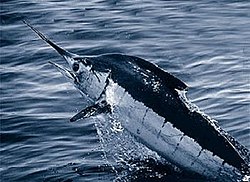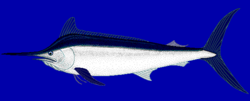Marlin
Family of fish From Wikipedia, the free encyclopedia
Marlins are fish from the family Istiophoridae, which includes between 9 and 11 species, depending on the taxonomic authority.
| Marlin Temporal range: | |
|---|---|
 | |
| Atlantic blue marlin (Makaira nigricans) | |
| Scientific classification | |
| Domain: | Eukaryota |
| Kingdom: | Animalia |
| Phylum: | Chordata |
| Class: | Actinopterygii |
| Order: | Carangiformes |
| Suborder: | Menoidei |
| Superfamily: | Xiphioidea |
| Family: | Istiophoridae Rafinesque, 1810 |
| Type genus | |
| Istiophorus Lacépède, 1801 | |
| Genera | |
Name
The family's common name is thought to derive from their resemblance to a sailor's marlinspike.[1]
Taxonomy
The family name Istiophoridae comes from the genus Istiophorus which first placed the species Istiophorus platypterus by George Kearsley Shaw in 1792 from the Greek word ἱστίον istion meaning "sail" that describes the shape of the species's dorsal fins.[2]: 6
Family description
Marlins have elongated bodies, a spear-like snout or bill, and a long, rigid dorsal fin which extends forward to form a crest.
Marlins are among the fastest marine swimmers. However, greatly exaggerated speeds are often claimed in popular literature, based on unreliable or outdated reports.[3]
The larger species include the Atlantic blue marlin, Makaira nigricans, which can reach 5 m (16 ft) in length and 820 kg (1,810 lb) in weight[4] and the black marlin, Istiompax indica, which can reach in excess of 5 m (16 ft) in length and 670 kg (1,480 lb) in weight. They are popular sporting fish in tropical areas. The Atlantic blue marlin and the white marlin are endangered due to overfishing.[5]
Marlins can change colour, lighting up their stripes just before attacking prey.[6]
Classification
Summarize
Perspective
The marlins are Istiophoriform fish, most closely related to the swordfish (which itself is the sole member of the family Xiphiidae). The carangiformes are believed to be the second-closest clade to marlins. Although previously thought to be closely related to Scombridae, genetic analysis only shows a slight relationship.
Extant genera
| Image | Genus | Living species | Common name |
|---|---|---|---|
 black marlin | Istiompax (Whitley, 1931) | Istiompax indica | black marlin |
 Atlantic sailfish | Istiophorus (Lacépède, 1801) | I. albicans | Atlantic sailfish |
| I. platypterus | Indo-Pacific sailfish | ||
 Atlantic blue | Makaira (Lacépède, 1802) | Makaira nigricans (Lacepède, 1802) | Atlantic blue marlin |
| Makaira mazara (Jordan & Snyder, 1901) | Indo-Pacific blue marlin | ||
 white marlin | Kajikia (Hirasaka & H. Nakamura, 1947) | Kajikia albida (Poey, 1860) | white marlin |
| Kajikia audax (Philippi (Krumweide), 1887) | striped marlin | ||
 longbill | Tetrapturus (Rafinesque, 1810) | Tetrapturus angustirostris (S. Tanaka (I), 1915) | shortbill spearfish |
| Tetrapturus belone (Rafinesque, 1810) | Mediterranean spearfish | ||
| Tetrapturus georgii (R.T. Lowe, 1841) | roundscale spearfish | ||
| Tetrapturus pfluegeri (C. R. Robins & de Sylva, 1963) | longbill spearfish |
Fossil genera
Marlins have a continuous fossil record from the Miocene onwards, with the oldest uncontroversial fossil dated to 22 million years ago.[7] It is thought that they probably evolved in the Paratethys Sea.[8]
The following fossil genera are known:[9][10]
- †Morgula Gracia et al., 2022
- †Pizzikoskerma Gracia, Villalobos-Segura, Ballen, Carnevale & Kriwet, 2024
- †Prototetrapturus Gracia et al., 2022
- †Sicophasma Gracia, Villalobos-Segura, Ballen, Carnevale & Kriwet, 2024
- †Spathochoira Gracia et al., 2022

Popular culture

In the Nobel Prize-winning author Ernest Hemingway's 1952 novel The Old Man and the Sea, the central character of the work is an aged Cuban fisherman who, after 84 days without success on the water, heads out to sea to break his run of bad luck. On the 85th day, Santiago, the old fisherman, hooks a resolute marlin; what follows is a great struggle between man, sea creature, and the elements.
Frederick Forsyth's story "The Emperor", in the collection No Comebacks, tells of a bank manager named Murgatroyd, who catches a marlin and is acknowledged by the islanders of Mauritius as a master fisherman.
A marlin features prominently in the last chapter and climactic scenes of Christina Stead's The Man Who Loved Children. Sam's friend Saul gives Sam a marlin, and Sam makes his children help him render the fish's fat.
The Miami Marlins, a professional baseball team based in Miami, Florida, is named after the fish.
In Finding Nemo, Nemo’s father’s name is Marlin.
See also
References
Further reading
External links
Wikiwand - on
Seamless Wikipedia browsing. On steroids.
